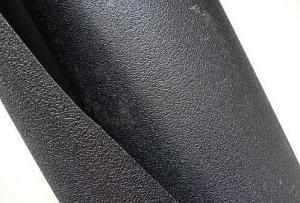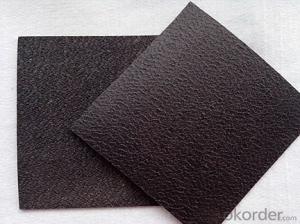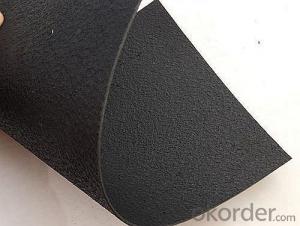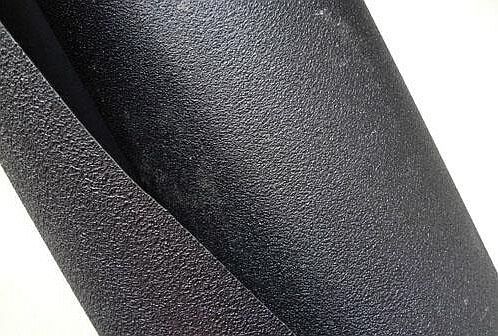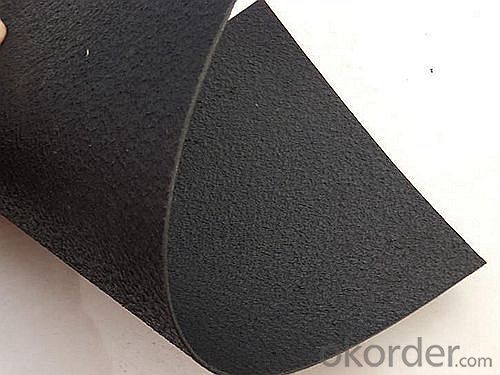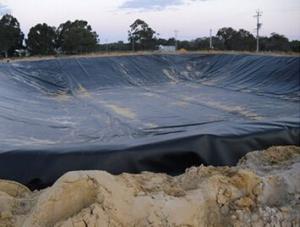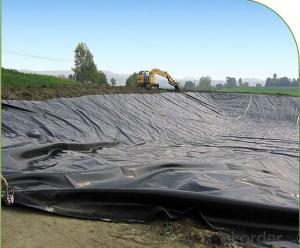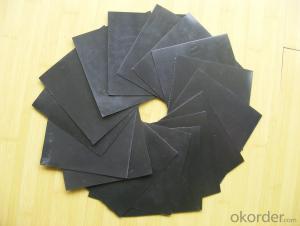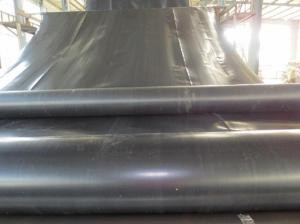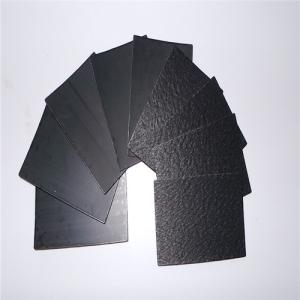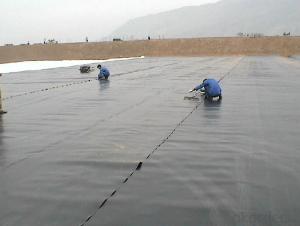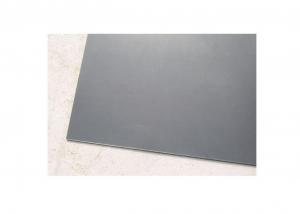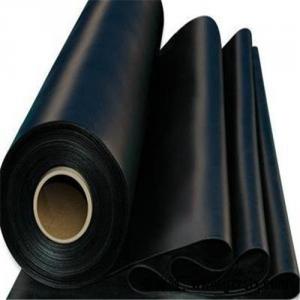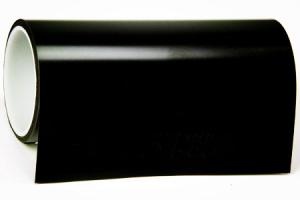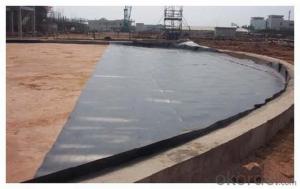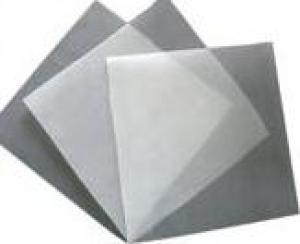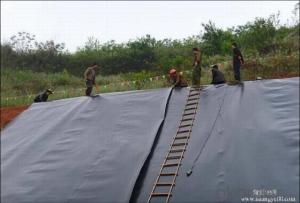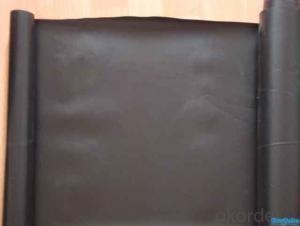60 Mil HDPE Geomembrane for Aquaponics Construction
- Loading Port:
- China main port
- Payment Terms:
- TT OR LC
- Min Order Qty:
- 1000 m²
- Supply Capability:
- 1000000 m²/month
OKorder Service Pledge
OKorder Financial Service
You Might Also Like
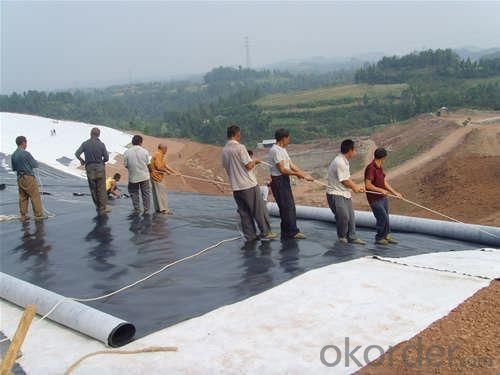
Geomembrane
Color:Black or at your request
Density: 0.94g /cm3
Temperature range: -60oC -- +60oC
Life time: more than 50 years
Executive standard: GB/T 17643-2011
Features: Excellent environment stress resistant cracking performance and chemical erosion resistance.
Big scope of application temperature and long service life.
Composite Geomembrane with impermeable plastic film as a substrate, and non-woven geotextile composite made of impermeable material, which depends on the seepage properties of a impermeable plastic film performance. Is a kind of polymer chemistry flexible material, the proportion of small, extensible stronger ability to adapt to high deformation. Corrosion resistance, low temperature, frost good performance. Have better resistance to erosion, are not afraid of acid, alkali and salt erosion.
Our Service
1.On a regular basis or as per your request,we entrust national testing agencies to conduct quality inspections
2. Strictly in accordance with the ISO9001-2008 international quality system standard,we monitor and manage the whole process throughout production,quality testing,and measurement to ensure product quality
3. For quality-related construction delay or substandard construction(except for damage or losses due to customer’s responsibility or irresistible natural disasters),we have refunding,replacement,and repair services.We will respond to customers’ feedbacks on quality issues within 24 hours.
FAQ:
Q: What kind of payments does jenor support?
A: T/T, L/C, Cash are accepted.
Q: Do you charge for the samples?
A: Accordeing to our company policy, the samples are free, we only charge the freight fee. And we will return the freight fee during the next order.
Q: Can you produce according to customers' design?
A: Sure, we are professional manufacturer, OEM and ODM are both welcome.
Q: Do you have other products?
A: Yes, please check the pictures:
- Q: What is the soft membrane?
- Soft membrane ceiling——was established in 19th century in Switzerland, then was researched and improved by Mr French farmland SCHERRER (Ferrand. Driscoll) in 1967 and successfully extended to the European and American soft membrane ceiling market, thus, soft membrane ceiling has increasingly become the top choice of suspended ceiling materials. Soft membrane is made of special polyvinyl chloride ethylene material, 0.18 - 0.2 mm,weigning 180 ~ 320 g per square meter, and its fire prevention level is B1 level. Soft membrane is shaped by one or more cutting and finished by high frequency welding. Soft membrane is made in the factory after measuring the size of ceiling. Size stability of soft membrane is at -15 degrees to 45 degrees celsius. Transparent membrane ceiling can cooperate with various lighting systems (such as neon lights, fluorescent lights, LED lights) to create a dreamy, shadowless indoor lighting effects. At the same time, it abandoned the heaviness of glass or organic glass, danger and small pieces assembly and other shortcomings, and has gradually become a new decorative highlights.
- Q: How do geomembranes provide insulation in roofing systems?
- Geomembranes provide insulation in roofing systems by acting as a barrier between the roof surface and the external environment. They are typically made of synthetic materials, such as rubber or plastic, which have high thermal resistance. This helps in reducing heat transfer, preventing loss of energy, and maintaining a stable temperature within the building. Additionally, geomembranes also provide protection against moisture, UV radiation, and other weather elements, thereby enhancing the overall performance and longevity of the roofing system.
- Q: How do geomembranes contribute to the preservation of endangered species?
- Geomembranes are synthetic membranes that are impermeable to liquids and gases, making them a useful tool in the preservation of endangered species. These membranes can be used to construct artificial habitats, such as ponds or enclosures, that mimic the natural habitats of these species. By providing a controlled environment, geomembranes help protect endangered species from predators, invasive species, and human disturbances. Additionally, geomembranes can be used to create barriers that prevent the contamination of water bodies, thus safeguarding the delicate ecosystems on which these endangered species rely. Overall, geomembranes play a crucial role in preserving the habitats and ensuring the survival of endangered species.
- Q: How do geomembranes prevent leaks?
- Geomembranes prevent leaks by acting as a barrier between liquids or gases and the surrounding environment. They are made from durable materials that are impermeable, such as high-density polyethylene or PVC. These membranes are installed to create a continuous liner, effectively sealing off the area and preventing any leakage. Additionally, geomembranes can be welded or seamed together to ensure a watertight and leak-proof seal. Overall, geomembranes provide a reliable and long-lasting solution to prevent leaks and protect the environment.
- Q: What are the advantages of using geomembranes in hazardous waste containment?
- The advantages of using geomembranes in hazardous waste containment include their impermeability, high chemical resistance, and ability to prevent contamination of surrounding soil and groundwater. They also provide durability, long-term stability, and ease of installation. Additionally, geomembranes offer flexibility in design, allowing for customization to fit the specific needs of different hazardous waste containment sites.
- Q: How do geomembranes prevent leachate seepage in landfill capping?
- Geomembranes prevent leachate seepage in landfill capping by providing a durable and impermeable barrier between the waste materials and the surrounding environment. These specially designed synthetic liners are made from materials such as high-density polyethylene (HDPE) or polyvinyl chloride (PVC) and are installed as a part of the landfill capping system. Their primary function is to prevent the leachate, which is the liquid that forms when water interacts with the waste, from escaping into the soil and contaminating groundwater or nearby water bodies. The geomembranes act as a reliable barrier, effectively stopping the leachate from seeping through and ensuring that it is collected and properly managed within the landfill system.
- Q: how long can we turn on the air conditioning after screen protector?
- Yes, but you can not be expelled from the fog line. it is best to stick the switch, do not open the window until thirty-five days later. Rear window except demister wire can not be energized within a week, heat is likely to cause deformation of the film. Do not lift the doors within a week to prevent the film shifts and rollings.
- Q: Is geotechnical membrane dedicated KS glue poisonous?
- This is non-toxic. Generally, fish pond, shrimp pool, reservoir paving impermeable geomembrane construction would use geomembrane special adhesive, because it is cheaper than welding, convenient and simple.
- Q: How to choose glossy and matte geomembrane used in refuse landfill ?
- Hope it is easy to understand because it is not complicated at all. Actually, the dfference between matte and glossy membrane is the coarse surface, which is to increase friction. I f it is for refuse landfill, there are mainly three parts needed geomembrane for seepage-proof. reservoir bottom, side slope and cover (or closure). For "reservior bottom" , pave a layer of imported glossy geomembrane at the bottom of the landfill for horizontal seepage prevention. For side slope, use matte geomembrane around the landfill to increase friction because the side slope has vertical angle, that is, to make the geomembrane hung on the side slope. For cover or enclosure, use glossy membrane for horizontal seepage prevention to prevent rain pouring into the reservior and percolate increasing and isolate the garbage in landfill from the outside. It may not be comprehensive, but from practical experience coorperated with Canada Solmax Inc. Hope it's helpful.
- Q: The installation method of soft film ceiling.
- The technological process: 1. To fix the permanent support. 2. To fix the Aluminum Alloy kell. 3. To install the soft film. 4. To clean the soft flower.
Send your message to us
60 Mil HDPE Geomembrane for Aquaponics Construction
- Loading Port:
- China main port
- Payment Terms:
- TT OR LC
- Min Order Qty:
- 1000 m²
- Supply Capability:
- 1000000 m²/month
OKorder Service Pledge
OKorder Financial Service
Similar products
Hot products
Hot Searches
Related keywords
